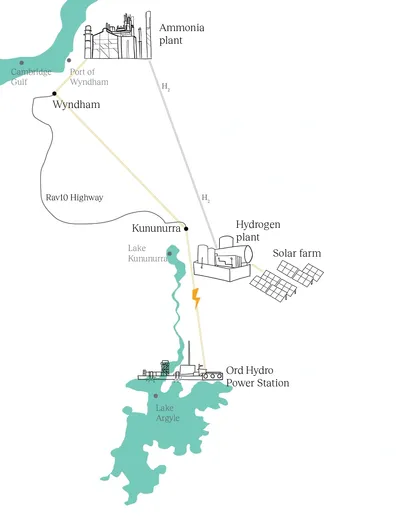Aboriginal Clean Energy Partnership: renewable ammonia production in Western Australia
By Geofrey Njovu on July 26, 2023

Global investment & advisory firm Pollination will partner with local Indigenous communities in Western Australia to develop the East Kimberley Clean Energy Project. The project will produce up to 250,000 tonnes per year of renewable ammonia, powered by a greenfield 900 MW solar farm built over 2,000 hectares of heritage land near Kununurra.
Freshwater from Lake Argyle will be used for hydrogen production via electrolysis. The hydrogen will then be transported to the Port of Wyndham through a new 120 km pipeline, with ammonia production to take place near the coast. Ord Hydro Power Plant, an existing hydro facility at Lake Argyle, will supply the ammonia facility’s baseload renewable energy. The hydro facility has significant spare generating capacity since the closure of the nearby Argyle diamond mine in 2020, and in 2021 an electrolysis feasibility study was conducted with support from the WA state government.
Thus far, scoping has been completed, and further development will be carried out over the next 12 months. Subject to feasibility studies and capital raising, construction is projected for late 2025 and production for late 2028. The ammonia produced will be used for local agriculture and for export to Asia and Europe.
This project represents a just, ambitious and achievable vision for Australia’s clean energy future. It leverages the natural advantages and existing energy and port infrastructure already in place in the East Kimberley region to create a major new clean energy export hub that will help Australia and our region decarbonise, grow new industries and ensure traditional owners and local residents are shareholders, not just stakeholders, in the benefits…
Rob Grant, Pollination Head of Projects, in his organisation’s official press release, 18 July 2023
Dozens of governments worldwide, many of them in our neighbourhood, have already issued a hydrogen strategy – flagging how critical this resource is going to be as the world moves towards net zero. The Australian Government has placed green hydrogen at the heart of its plans to become a clean energy superpower in the future global economy and this is exactly the kind of project that will be critical in making good on that ambition.
A new partnership model to de-risk and accelerate development
The project’s operating entity, the Aboriginal Clean Energy (ACE) Partnership, will be equally owned by two local Aboriginal groups (MG Corporation & Balanggarra Aboriginal Corporation), Pollination and the Kimberley Land Council.
Shareholding will enable traditional landowners to directly influence decisions in the development process. They will also benefit more fully from the economic empowerment opportunities arising from their natural resource endowment.
Additionally, the equal partnership approach will help de-risk and accelerate project delivery due to simplified land access and environmental permitting compared to conventional strategies.
The ACE Partners bring differentiated but crucial individually lived experience and knowledge to this project. From cultural heritage, social engagement and remote land management to renewable energy and green hydrogen projects and industry experience, the suite of skills required to effectively deliver this ambitious project on traditional lands in the East Kimberley exists only within this consortium.
Cissy Gore-Birch, CEO of Balanggarra Aboriginal Corporation, in Pollination’s official press release, 18 July 2023
This project gives us a chance to be active shareholders, understanding the risks and rewards, and making informed decisions about long-term strategic projects on our Country.
Lawford Benning, MG Corporation Executive Chair, in Pollination’s official press release, 18 July 2023